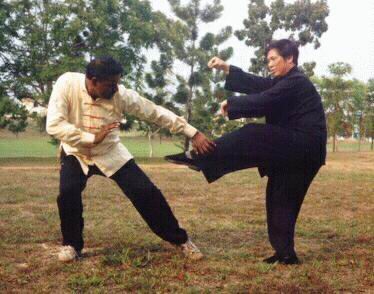HOW TO CONTINUE AFTER AN INTENSIVE COURSE

Combat Application
Question
I was wondering how one should continue practising Shaolin Kungfu after the Intensive course? The Shaolin kungfu course lays great foundations but as you have said many times, supervision under a master is vital. How would we know if our posture is wrong, or an application is done correctly even if we practice what we have learnt in the course?
-- Christopher, Singapore
Answer
All those who attend my Intensive Shaolin Kungfu Course, as well as my Intensive Taijiquan Cours, have prior kungfu or other martial art experience. Some of them have taught kungfu or other martial arts for many years. What they want to learn — which is also a main objective of my intensive course — is what they have been searching for for years, but could not find anywhere.
Explicitly, the two aspects they have been searching for are internal force training and combat application using the typical patterns they perform in solo practice. Yet, deep inside many of them is the search for the spiritual aspect of kungfu. My intensive courses fulfill these three needs. In fact my intensive courses are primarily for internal force training, combat application and spiritual cultivation.
The onus of my courses is not on teaching more and more forms, but helping students to acquire appropriate skills. The skills they successfully attain during my courses are actually quite fantastic, like attaining a one-pointed mind, entering a higher level of consciousness, tapping energy from the cosmos, generating internal energy flow, developing internal force, good timing and spacing, good judgment, quick-decision making, spontaneous response, fluidity of movement, expanding the spirit, and finding spiritual joy. After learning these skills and the methodology to acquire them during my intensive courses, practicing them on their own is not difficult.
To those who never have any experience of such training, these skills do not mean anything, they just remain as hollow words. Skills to expand the spirit and to find spiritual joys will be unintelligible to them. They either do not believe what we say or have a very different interpretation of what we mean.
Even the most basic of combat skills, good timing and spacing, may not be meaningful to the uninitiated. Many uninitiated students think they have good timing and spacing when actually they don't. Some do not even know what actually good timing and spacing are. They do not know, for example, the three points of time when we can respond to an opponent's movements, or how by placing a foot in a slightly different position can alter important factors in a combat situation.
Most think that they can naturally improve their timing and spacing through free sparring. This is not true. In fact free sparring without systematic preparation conditions the practitioners' bad habits and hinders further progress. Good timing and spacing need to be systematically trained. Most students do not spend any time at all in such training. Some are not even aware that such skills need to be trained; they presume that these skills come naturally with time.
Another question concerns sparring. How would a student practice sparring on his own after the course when he does not have a sparring partner? Those who ask this question have not learnt sparring systematically. If they have, they would realize that practicing on their own is very important. In fact that is how masters become very combat efficient, though they usually do not have sparring partners. Nevertheless, if you have a sparring partner who attend my intensive courses together with you, it will be a great advantage, especially at the earlier stages. But you still have to practice a lot on your own.
During the intensive courses, you will have many opportunities to practice sparring with different partners. You will learn sufficient training methods and relevant combat skills that enable you to practice sparring competently on your own after the courses. The methodological training during the courses, including explanation of basic philosophy and principles, will enable you not only to know if your postures are wrong, or an application is done correctly, but also to perform more efficiently techniques that you learned earlier elsewhere or that you may learn from other sources later.
A rough analogy with learning how to drive may be useful. Let us say you have a car but do not know how to drive, just like you have kungfu forms but do not know how to use them in combat. After you have successfully learnt the skills of driving, you can continue to practice driving on your own and you can drive any other cars. Similarly, after you have successfully learnt the skills of kungfu, you can practice kungfu on your own and you may use other kungfu forms.
The above is taken from Question 4 May 2004 Part 1 of the Selection of Questions and Answers.
LINKS
Courses and Classes
